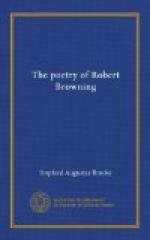The new art conquered the old. The whole life of Florence was soon painted as it was: the face of the town, the streets, the churches, the towers, the winding river, the mountains round about it; the country, the fields and hills and hamlets, the peasants at work, ploughing, sowing, and gathering fruit, the cattle feeding, the birds among the trees and in the sky; nobles and rich burghers hunting, hawking; the magistrates, the citizens, the street-boys, the fine ladies, the tradesmen’s wives, the heads of the guilds; the women visiting their friends; the interior of the houses. We may see this art of human life in the apse of Santa Maria Novella, painted by the hand of Ghirlandajo: in the Riccardi Palace, painted by Benozzo Gozzoli; in more than half the pictures of the painters who succeeded Fra Lippo Lippi. Only, so much of the old clings that all this actual Florentine life is painted into the ancient religious subjects—the life of the Baptist and the Virgin, the embassage of the Wise Men, the life of Christ, the legends of the saints, the lives of the virgins and martyrs, Jerusalem and its life painted as if it were Florence and its life—all the spiritual religion gone out of it, it is true, but yet, another kind of religion budding in it—the religion, not of the monastery, but of daily common life.
the
world
—The beauty and
the wonder and the power,
The shapes of things, their
colours, lights, and shades.
Changes, surprises—and
God made it all!
Who paints these things as if they were alive, and loves them while he paints, paints the garment of God; and men not only understand their own life better because they see, through the painting, what they did not see before; but also the movement of God’s spirit in the beauty of the world and in the life of men. Art interprets to man all that is, and God in it.
Oh,
oh,
It makes me mad to think what
men shall do
And we in our graves!
This world’s no blot for us,
No blank; it means intensely,
and means good:
To find its meaning is my
meat and drink.




